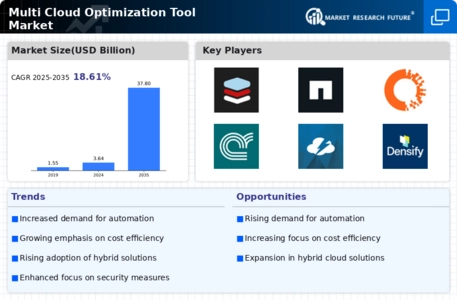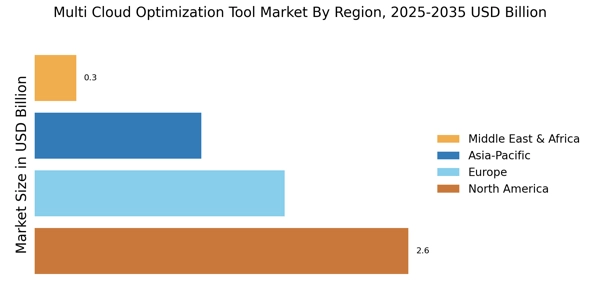The Multi Cloud Optimization Tool Market is currently characterized by a dynamic competitive landscape, driven by the increasing demand for efficient cloud resource management and cost optimization. Major players such as Microsoft (US), Amazon (US), and Google (US) are at the forefront, leveraging their extensive cloud infrastructures to enhance service offerings. Microsoft (US) has focused on integrating AI capabilities into its Azure platform, aiming to provide predictive analytics for resource allocation. Meanwhile, Amazon (US) continues to expand its AWS services, emphasizing automation and machine learning to streamline multi-cloud operations. Google (US) is enhancing its Anthos platform, which facilitates seamless management across various cloud environments, thereby positioning itself as a leader in hybrid cloud solutions. Collectively, these strategies indicate a trend towards innovation and technological advancement, shaping a competitive environment that prioritizes efficiency and user experience.
In terms of business tactics, companies are increasingly localizing their operations to better serve regional markets, which appears to be a response to the growing demand for tailored solutions. The market structure is moderately fragmented, with a mix of established players and emerging startups. This fragmentation allows for diverse offerings but also intensifies competition among key players, who are vying for market share through strategic partnerships and technological advancements.
In August 2025, IBM (US) announced a significant partnership with a leading telecommunications provider to enhance its multi-cloud optimization capabilities. This collaboration aims to integrate advanced networking solutions with IBM's cloud services, thereby improving data transfer speeds and reliability. The strategic importance of this partnership lies in its potential to offer customers a more robust and efficient cloud experience, which could significantly enhance IBM's competitive positioning in the market.
In September 2025, Oracle (US) unveiled a new suite of tools designed to optimize cloud costs for enterprises. This initiative focuses on providing real-time analytics and insights into cloud spending, enabling organizations to make informed decisions about resource allocation. The introduction of these tools reflects Oracle's commitment to addressing the financial aspects of cloud management, which is increasingly becoming a critical concern for businesses. By prioritizing cost optimization, Oracle is likely to attract a broader customer base seeking to enhance their cloud efficiency.
In October 2025, VMware (US) launched an innovative solution aimed at simplifying multi-cloud management for enterprises. This new offering integrates advanced automation features that allow businesses to manage their cloud resources more effectively. The strategic significance of this launch is underscored by the growing need for organizations to streamline their cloud operations amidst increasing complexity. VMware's focus on automation positions it well to capture market share as companies seek to enhance operational efficiency.
As of October 2025, the competitive trends in the Multi Cloud Optimization Tool Market are increasingly defined by digitalization, sustainability, and the integration of artificial intelligence. Strategic alliances are playing a crucial role in shaping the landscape, as companies collaborate to enhance their technological capabilities and service offerings. Looking ahead, it is anticipated that competitive differentiation will evolve, with a shift from price-based competition to a focus on innovation, technology, and supply chain reliability. This evolution suggests that companies that prioritize these aspects will likely emerge as leaders in the market.


















Leave a Comment